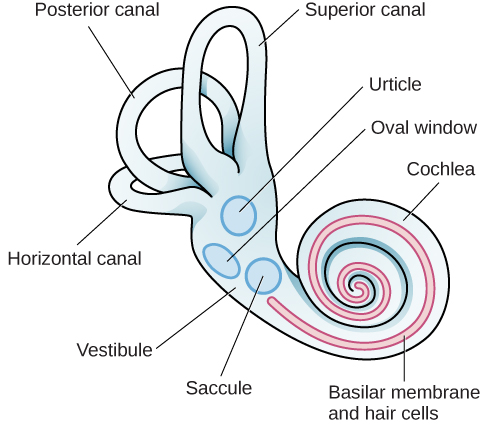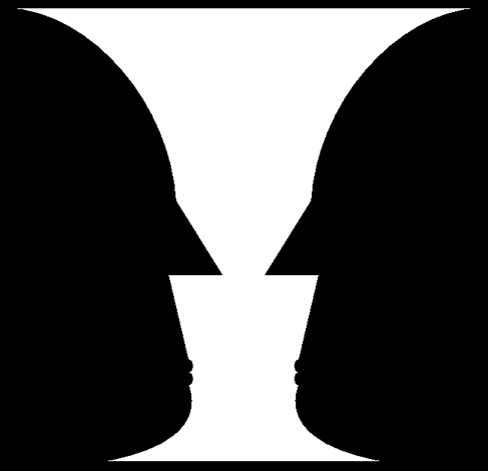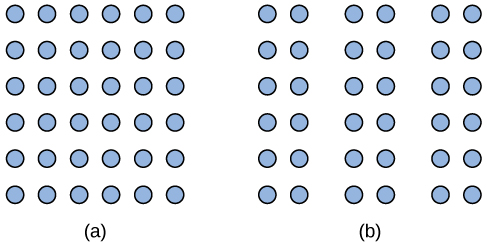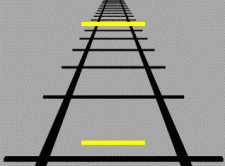Sensation and Perception
1/70
Earn XP
Description and Tags
(week 7)
Name | Mastery | Learn | Test | Matching | Spaced |
|---|
No study sessions yet.
71 Terms
Sensation
when sensory information is detected by a sensory receptor
Transduction
conversion from sensory stimulus energy to action potential
Absolute threshold
the minimum amount of stimulus energy that must be present for the stimulus to be detected 50% of the time
Subliminal messages
messages that are presented below the threshold for conscious awareness
Just noticeable difference (JND) or difference threshold
how much difference in stimuli is required to detect a difference between them; changes depending on the stimulus intensity
Weber’s Law
Ernst Weber’s discovery that the difference threshold is a constant fraction of the original stimulus and bigger stimuli require larger differences to be noticed
Perception
the way sensory information is organized, interpreted, and consciously experienced.
bottom-up processing
sensory information from a stimulus in the environment driving a process
top-down processing
to knowledge and expectancy driving a process
sensory adaptation
the reduction in sensitivity after prolonged exposure to a stimulus
Inattentional Blindness
the failure to notice something that is completely visible because the person was actively attending to something else and did not pay attention to other things
Signal detection theory
The ability to identify a stimulus when it is embedded in a distracting background
Amplitude
the height of a wave as measured from the highest point on the wave (peak or crest) to the lowest point on the wave (trough)
Wavelength
the length of a wave from one peak to the next
Frequency
the number of waves that pass a given point in a given time period; expressed in terms of hertz (Hz), or cycles per second; Longer wavelengths have lower frequencies, and shorter wavelengths have higher frequencies
Visible spectrum
the portion of the larger electromagnetic spectrum that we can see (380-740 nm in humans)
Electromagnetic spectrum
all of the electromagnetic radiation that occurs in our environment
Seeing color
red is associated with longer wavelengths, greens are intermediate, and blues and violets are shorter in wavelength
Colors with larger amplitudes appear brighter
Young-Helmholtz trichromatic theory of color vision
all colors in the spectrum can be produced by combining red, green, and blue. The three types of cones normal-sighted individuals have are each receptive to one of the colors. (Applies to visual processing on the retina)
opponent-process theory
color is coded in opponent pairs: black-white, yellow-blue, and green-red, and some cells of the visual system are excited by one of the opponent colors and inhibited by the other (Applies when the signal moves past the retina on its way to the brain)
Afterimage
the continuation of a visual sensation after removal of the stimulus
Depth perception
Our ability to perceive spatial relationships in three-dimensional (3-D) space
Binocular cues
rely on the use of both eyes
Binocular disparity
the slightly different view of the world that each of our eyes receives
Monocular cues
cues that require only one eye (ex. interposition, the partial overlap of objects, the relative size and closeness of images to the horizon, relative size, and the variation between light and shadow.)
Linear perspective
the fact that we perceive depth when we see two parallel lines that seem to converge in an image
vestibulo-ocular reflex
coordination of motion information with visual information that allows you to maintain your gaze on an object while you move.
Synesthesia
when one sensory signal gives rise to two or more sensations
Pitch and frequency
The frequency of a sound wave is associated with our perception of that sound’s pitch and they have a positive correlation; The audible range of sound frequencies for humans is between 20 and 20000 Hz, with greatest sensitivity to frequencies that fall in the middle.
Loudness and Amplitude
Higher amplitudes are associated with louder sounds. Loudness is measured in terms of decibels (dB), a logarithmic unit of sound intensity.
Timbre
sound’s purity, and it is affected by the complex interplay of frequency, amplitude, and timing of sound waves.
temporal theory of pitch perception
frequency is coded by the activity level of a sensory neuron (applies to frequencies up to about 4000 Hz)
Place theory of pitch perception
different portions of the basilar membrane are sensitive to sounds of different frequencies; the base responds best to high frequencies and the tip best to low frequencies
Interaural level difference
a sound coming from the right side of your body is more intense at your right ear than at your left ear because of the attenuation of the sound wave as it passes through your head
Interaural timing difference
the small difference in the time at which a given sound wave arrives at each ear
Deafness
the partial or complete inability to hear
Congenital deafness
being born without hearing
Conductive hearing loss
a problem delivering sound energy to the cochlea; causes include blockage of the ear canal, a hole in the tympanic membrane, problems with the ossicles, or fluid in the space between the eardrum and cochlea; problems are associated with a failure in the vibration of the eardrum and/or movement of the ossicles and are treated with devices like hearing aids (amplify incoming sound waves to make vibration of the eardrum and movement of the ossicles more likely to occur)
sensorineural hearing loss
Most common form of hearing loss; failure to transmit neural signals from the cochlea to the brain; causes include aging, head or acoustic trauma, infections and diseases, medications, environmental effects such as noise-induced hearing loss, tumors, and toxins
Ménière’s disease
results in a degeneration of inner ear structures that can lead to hearing loss, tinnitus (constant ringing or buzzing), vertigo (a sense of spinning), and an increase in pressure within the inner ear; results in sensorineural hearing loss
Cochlear implants
electronic devices that consist of a microphone, a speech processor, and an electrode array; receives incoming sound information and directly stimulates the auditory nerve to transmit information to the brain.
Taste buds
formed by groupings of taste receptor cells with hair-like extensions that protrude into the central pore of the taste bud
Pheromone
chemical message sent by another individual; Pheromonal communication often involves providing information about the reproductive status of a potential mate
Inflammatory pain
Pain that signals some type of tissue damage
Neuropathic pain
pain from damage to neurons of either the peripheral or central nervous system
congenital insensitivity to pain (or congenital analgesia)
can detect differences in temperature and pressure, they cannot experience pain.
Vestibular sense
contributes to our ability to maintain balance and body posture
It’s major sensory organs (utricle, saccule, and the three semicircular canals) are located next to the cochlea in the inner ear.
The vestibular organs are fluid-filled and have hair cells, similar to the ones found in the auditory system, which respond to movement of the head and gravitational forces. When these hair cells are stimulated, they send signals to the brain via the vestibular nerve.
Although we may not be consciously aware of our vestibular system’s sensory information under normal circumstances, its importance is apparent when we experience motion sickness and/or dizziness related to infections of the inner ear

Proprioception
The sense of the position of parts of the body, relative to other neighboring parts of the body. Focuses on the body’s cognitive awareness of movement.
kinesthesia
Awareness of the position and movement of the parts of the body using sensory organs in joints and muscles. Kinesthesia is a key component in muscle memory and hand-eye coordination. It is more behavioral than proprioception.
Both proprioception and kinesthesia:
interact with information provided by the vestibular system
gather information from receptors that respond to stretch and tension in muscles, joints, skin, and tendons
information travels to the brain via the spinal column
Several cortical regions in addition to the cerebellum receive information from and send information to the sensory organs of these systems.
Gestalt psychology
field of psychology based on the idea that the whole is different from the sum of its parts; this means that the brain creates a perception that is more than simply the sum of available sensory inputs, and it does so in predictable ways
Figure-ground relationship
we tend to segment our visual world into figure and ground. Figure is the object or person that is the focus of the visual field, while the ground is the background

Proximity
things that are close to one another tend to be grouped together (ex. How we read)

Similarity
things that are alike tend to be grouped together
law of continuity
we are more likely to perceive continuous, smooth flowing lines rather than jagged, broken lines
Closure
we organize our perceptions into complete objects rather than as a series of parts
Pattern perception
our ability to discriminate among different figures and shapes; occurs by following the Gestalt principles
Perceptual hypotheses
educated guesses that we make while interpreting sensory information
Sensory modalities
a type of sense; for example, vision or audition
unimodal
of or pertaining to a single sensory modality
Multimodal
of or pertaining to multiple sensory modalities
Multimodal perception
the effects on the perception of events and objects in the world that are observed when there is information from more than one sensory modality
Multimodal phenomena
the binding of inputs from multiple sensory modalities and the effects of this binding on perception
crossmodal phenomena
the influence of one sensory modality on the perception of another
McGurk effect
What you see overrides what you hear
Why do scientists use illusions?
To explore what people experience, what parts of the brain are involved in interpretation of the illusion, and what variables increase or diminish the strength of the illusion
Ponzo Illusion
When two horizontal lines of equal length appear to be different lengths due to converging lines

Benary cross
cross with two triangles; triangle on the left looks lighter because it is against a darker background, but both triangles are the same shade.
Ebbinghaus illusion
shows two orange circles of the same size but surrounded by gray circles of different sizes, creating the illusion of the orange circles being different sizes
Counterbalancing
Making sure that all conditions of an experiment are equally exposed to the positive or negative effects of which order the tasks are completed
Confounding variable
A practice/fatigue not apart of the experiment that influences performance